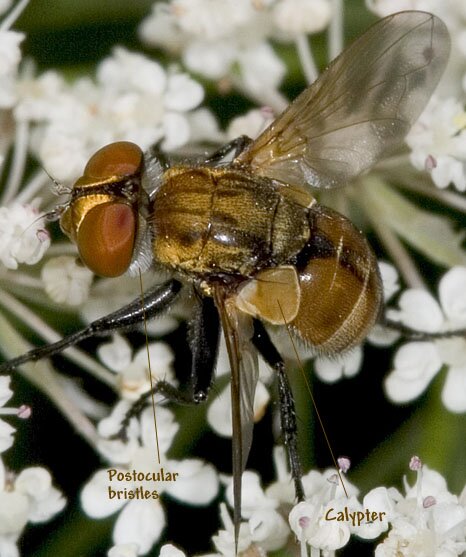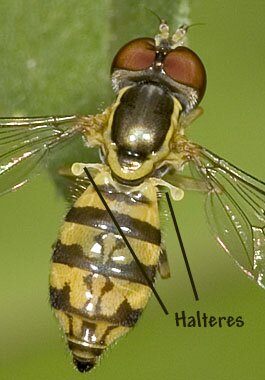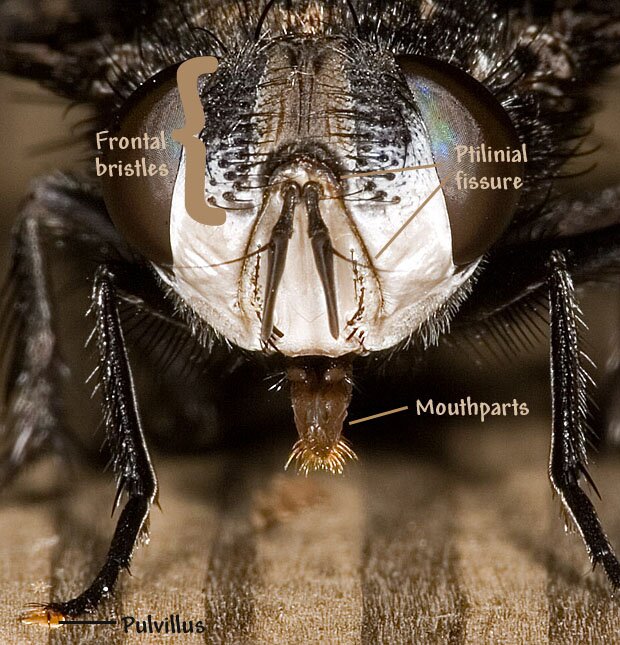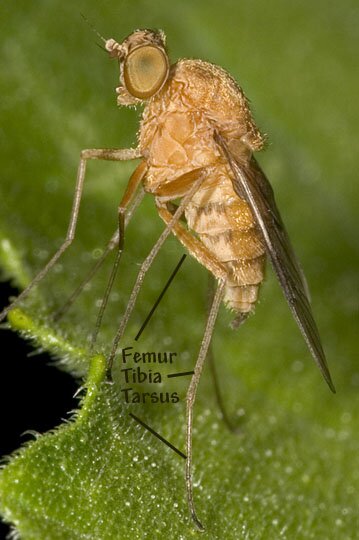
Apex. The portion of a body part that is farthest of the central body or from the base. The apex of an antenna is the tip. The apex of the pronotum is the part nearest the head. The apex of the abdomen is the posterior (rearmost) portion. The plural of apex is apices. The opposite of apex is base.
Antennomere. A segment of the antenna.
Apical. Pertaining to the apex.
Arista. A bristle that arises from the antenna. Some arista are apical, projecting from the apex of the antennae, while others are dorsal, emerging from the dorsum of the antenna.
Aristate. Bearing an arista.
Basal. Pertaining to the base.
Base.The portion of a body part that is closest to the central body and farthest from the apex. The base of the elytra is the part nearest the pronotum, and the base of the pronotum is the part nearest the elytra. The base of an antenna is the part nearest the head. The opposite of base is apex.

Calypters. Flexible structures, often pale in color, found at the base of the wings of the more advanced fly families. The calypters cover and conceal the halteres.
Chaetotaxy. The systematic study of the position and numbers of setae. Chaetotaxy is especially important in the taxonomy of Diptera.
Congener. Said of a species that is in the same genus as the species at hand.
Costa. The leading edge of the wing.
Dichoptic. With the compound eyes not touching each other.
Diurnal. Active during the day; the opposite of Diurnal is nocturnal.
Dorsal. The back, generally seen in a birds eye view of the fly.
Edges. The side margins of a structure.
Femur. The first elongate leg segment. Moving apically, the femur is attached to the tibia which is then attached to the tarsi. The plural of femur is femora.
Frontal bristles. Bristles emerging from the frontal area of the head. They are paired and often arch over the medial portion of the head.
Halteres. The very small, vestigial second pair of wings found in members of the Order Diptera. Halteres are believed to play a role in flight balance. The singular of halteres is haltere or occasionally halter.
Instar. A period in the life of a larva, either between hatching and the first molt, or between two molts, or between a molt and pupation.
Holoptic. With the compound eyes touching along the middle of the dorsal and frontal areas of the head.
Integument. The outer covering of the insect’s body; analogous to "skin," and has also been compared to vertebrates’ skeletal system.
Longitudinal. Going in the "length" direction on the fly as opposed to the "width" direction.
Margins. The edges.
Oblique. At an angle; neither horizontal nor vertical; diagonal.
Ocellar bristles. Paired bristles that arise in or near the ocellar triangle.
 Ocellar triangle. The area surrounding the ocelli, typically three-sided, and often set apart by color or by being raised.
Ocellar triangle. The area surrounding the ocelli, typically three-sided, and often set apart by color or by being raised.
Ocelli. Simple eyes. The singular of ocelli is ocellus.
Orbital bristles. Bristles near the edge of the eye, between the edge of the eye and the medial portion of the head.
Palpus. A short, segmented structure associated with the mouthparts; one pair is located on the maxillae and one pair on the labium. The plural of palpus is palpi.
Plumose. Feather-like.
Post-ocellar bristles. Bristles emerging from behind the ocellar triangle.
Postocular bristles. Bristles, often numerous, emerging from behind the eye. When present, they are often the rearmost feature of the fly’s head.
Ptilinial fissure (Ptilinial suture). A somewhat arch-shaped, slit-like opening in the front of the head, though which a balloon-like structure is everted and expanded, thus helping the fly escape from the puparium. The less-advanced families of Diptera do not have the Ptilinial fissure.

Pubescent. Bearing soft, short hairs.
Pulvillus. Pad on the ventral side of the apex of the tarsi, found in some fly families. The plural of pulvillus is pulvilli.
Punctate. Bearing impressed dots.
Scape. The basal segment of the antennae.
Scutellar bristle. A bristle arising from the scutellum.
Scutellum. The small, flat, structure located behind the scutum. Typical shapes include triangular and semi-circular.
Scutum. The dorsal surface of the thorax, anterior to the scutellum.
Setae. Bristles, stiffened hairs. The singular of setae is seta.
Sinuate. Said of a line or an edge that is wavy.
Spurious vein. A line on the wings of Syrphid Flies, not found on the wings of other families.
Striae. Impressed lines; the singular of striae is stria.
Striate. With striae present.
 Striations. Same as striae.
Striations. Same as striae.
Tarsus. The apical section of the leg, made up of several segments; the "foot." At its basal end the tarsus is attached to the tibia. The plural of tarsus is tarsi.
Tibia. The shin; the middle section of the leg. At its basal end the tibia is attached to the femur; at its apical end the tibia is attached to the tarsus. The plural of tibia is tibiae.
Transverse. Going in the "width" direction on the beetle as opposed to the "length" direction.
Transverse suture. A line dividing the scutum into an anterior half and a posterior half; the suture may be prominent, faint, or lacking.
Vertex.The highest part of the dorsal surface of the head.
Vertical bristles. Bristles arising from the vertex.
Vibrissae. Paired bristles arising below the fly’s mouth, and often downward-pointing. The singular of vibrissae is vibrissa.
Insects of West Virginia